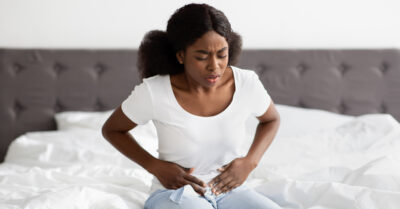Endometriosis
 What is endometriosis?
What is endometriosis?
Endometriosis is a chronic and often painful condition of the uterus. Cells similar to those lining inside the uterus, called endometrium, start to grow outside the uterus. This abnormal growth can occur on the ovaries, fallopian tubes, and the tissue lining the pelvis. In rare cases, it may also spread beyond the pelvic organs.
In a normal menstrual cycle, the endometrium thickens in preparation for a pregnancy. If fertilization doesn’t occur, the lining breaks down and is shed from the body. The blood and tissue exit the uterus as menstrual (period) blood.
With endometriosis, because the abnormal cells resemble endometrial cells, they behave similarly – building up, then breaking down and bleeding. However, because it has no way for this blood and tissue to exit the body, it becomes trapped. This leads to the formation of cysts, irritation, scar tissue, and adhesions, which can cause pain and fertility issues.
Endometriosis Symptoms
Endometriosis symptoms range from mild to severe. The severity of pain doesn’t always match the severity of the condition. Some of the most common symptoms are:
Painful Periods (Dysmenorrhea)
Pain usually starts a few days before menstruation and can linger a few days after your period ends. This isn’t just the typical cramping women without the condition experience; it’s often described as severe and debilitating.
Pain with Intercourse
Pain during or after sex is another common symptom of endometriosis. This pain can range from a sharp, stabbing sensation to a deep, lingering discomfort.
Pain with Bowel Movements or Urination
These symptoms are usually most pronounced during a woman’s period.
Excessive Bleeding
Some women with endometriosis may experience heavy periods (menorrhagia). They may also have bleeding or spotting between periods (menometrorrhagia).
Infertility
Endometriosis is also linked to fertility problems. Some women only discover they have the condition when seeking infertility treatment, especially in mild cases.
Other Symptoms
These may include fatigue, diarrhea, constipation, bloating, or nausea, especially during menstrual periods.
Some women with endometriosis may not experience any noticeable symptoms. For others, the symptoms are severe enough to interfere with their quality of life.
Endometriosis shares symptoms with conditions like pelvic inflammatory disease (PID), ovarian cysts, or irritable bowel syndrome (IBS). A thorough workup is necessary to differentiate these conditions.
Causes of Endometriosis
The exact cause of endometriosis is still unknown, but several theories are being studied.
Retrograde Menstruation
This is the most widely accepted theory. Retrograde menstruation happens when menstrual blood containing endometrial cells flows back through the fallopian tubes and into the pelvic cavity instead of out of the body. These endometrial cells then adhere to pelvic walls and surfaces of pelvic organs, where they grow and continue to thicken and bleed throughout menstrual cycles.
Transformation of Peritoneal Cells
Another hypothesis suggests that hormones or immune factors may induce specific cells lining the abdomen (peritoneal cells) to transform into endometrial-like cells.
Embryonic Cell Transformation
Hormones like estrogen might transform embryonic cells in the earliest stages of development into endometrial-like cells during puberty.
Surgical Scar Implantation
Endometrial cells might attach to the surgical incision after surgeries, such as a cesarean section or hysterectomy.
Immune System Disorder
It’s possible that endometrial cells grow outside the uterus in many women. An impaired immune system might be unable to recognize and destroy endometrial-like tissue growing outside the uterus, allowing it to grow.
Circulatory or Lymphatic System Spread
One theory suggests endometrial cells might spread via the blood or lymphatic system to other parts of the body.
Genetics
Endometriosis tends to run in families, suggesting that there may be a genetic component to the condition. If a woman’s mother or sister has endometriosis, her risk of developing it is higher.
Diagnosis
Diagnosing endometriosis can be challenging, primarily due to the wide range of symptoms that can mimic those of other conditions. A thorough diagnostic plan is needed to determine if endometriosis is present.
Medical History and Physical Examination
Your gynecologist will typically begin by asking about symptoms, menstrual history, and potential family history. A pelvic exam is generally performed next. The doctor will check the pelvis for abnormalities like cysts or painful areas.
Imaging Tests
Imaging tests provided valuable information about the uterus and associated structures. It is also helpful in ruling out other diseases with symptoms similar to endometriosis.
- Ultrasound: An external or transvaginal ultrasound can provide images of the reproductive organs. While ultrasound allows for visualizing cysts associated with endometriosis (endometriomas), it might not definitively diagnose endometriosis.
- Magnetic Resonance Imaging (MRI): An MRI provides a more detailed view of the organs and tissues, helping your provider to identify the location and size of endometrial implants.
Laparoscopy
This surgical procedure is considered the gold standard for diagnosing endometriosis. During a laparoscopy, a surgeon makes a small incision near the navel and inserts a tiny camera, looking for endometrial tissue outside the uterus. It’s the only diagnostic test allowing a direct visual inspection of the abdominal cavity. If endometrial tissue is found, it can be biopsied for further analysis.
Endometriosis Treatment
Endometriosis treatment focuses on managing symptoms and addressing fertility complications if they arise. The best approach often depends on the individual’s age, severity of symptoms, and whether or not they hope to become pregnant. Common treatment options include:
Pain Medication
Over-the-counter pain relievers, like ibuprofen or naproxen sodium, can help ease painful menstrual cramps associated with endometriosis. For more severe pain, a physician may prescribe stronger medications.
Hormone Therapy
Endometriosis is hormonally driven, mainly by estrogen. Several hormonal therapies can help, many of which aim to reduce estrogen:
- Birth Control Pills: Continuous cycle regimens, where menstruation is minimized, can reduce or eliminate pain.
- Gonadotropin-Releasing Hormone (Gn-RH) Agonists and Antagonists: These reduce estrogen and prevent menstruation, essentially placing the body in a menopausal state. This can halt endometrial tissue growth and reduce or eliminate period-associated pain.
- Progestin Therapy: The hormone progestin can stop menstrual periods and endometrial growth, relieving symptoms.
- Danazol: This drug suppresses the growth of the endometrium by blocking the production of ovarian-stimulating hormones, reducing estrogen levels.
Surgical Options
- Laparoscopic Surgery: Endometrial growths and scar tissue are removed, often alleviating pain. It can be an option for those trying to get pregnant since hormone therapy will also prevent pregnancy.
- Hysterectomy: In severe cases, when other treatments have failed, removing the uterus and sometimes the ovaries might be considered. This is typically a last-resort option.
Fertility Treatment
If endometriosis has led to fertility problems, assisted reproductive technologies, like in vitro fertilization (IVF), can help increase the chances of conceiving.
Alternative Treatments
Some women have found relief from endometriosis pain through alternative treatments like acupuncture, chiropractic care, and certain dietary adjustments. However, the effectiveness of these treatments isn’t well-documented in scientific literature, so it’s vital to consult your gynecologist before pursuing them.
Lifestyle and Home Remedies
Regular exercise, relaxation techniques, and applying heat can sometimes help alleviate pain associated with endometriosis.
Frequently Asked Questions (FAQs)
Can you get pregnant with endometriosis?
Many women with endometriosis can get pregnant, though the condition can sometimes affect fertility.
Can endometriosis cause cancer?
While endometriosis is benign, it can slightly increase the risk of certain types of ovarian cancer.
What does endometriosis feel like?
Endometriosis often causes pain, especially during menstruation, ranging from mild cramping to severe and debilitating discomfort.
What are the first signs of endometriosis?
Early signs include painful periods, pelvic pain, pain during intercourse, and heavy menstrual bleeding.
Is endometriosis genetic?
There seems to be a genetic component to endometriosis; women with a family history are at a higher risk.
Quick Facts
OB/GYN Doctors
Testimonials
“Great service. Dr. Shelton was my OB and delivered my son. He was always willing to answer questions and very knowledgeable. He was kind and courteous during delivery because let’s be honest… that’s not the most flattering moment in a woman’s life.” – BW
“I started with Dr. Eagan as my OBGYN in 2019 with my first pregnancy. He is an amazing doctor, made me feel comfortable, and I never felt judged for questions I had as a first time mom. Overall he is very personable and kind. He will walk you through any procedure that may need to be done and why. He treats each patient with kindness and dignity no matter your situation. I am now seeing him for my second pregnancy and he is just as humble and helpful as he was for my first pregnancy. I would recommend him for any OBGYN needs.” – DW
“I absolutely love Dr. Kelly. I’m on my third pregnancy now and she has been my OB for all three. She’s always understanding and considerate when I need someone to talk too and she always makes sure I don’t have any additional questions before our appointment is over. She will ALWAYS be my recommended OB at the Women’s Health Center.” – KM






